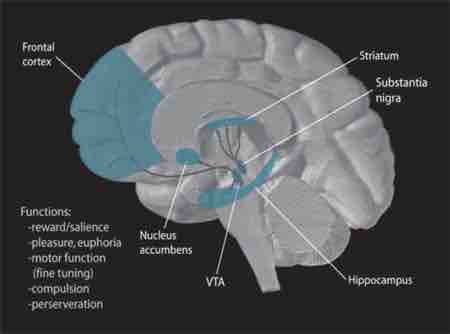The purpose of biological drives is to correct disturbances of homeostasis. According to drive-reduction theory, the body is motivated to engage in whatever behavior is necessary to fulfill an unsatisfied drive. One way that the body elicits this behavioral motivation is by increasing physiological arousal. Arousal theory expands upon drive-reduction theory by taking into account levels of arousal as potential motivators. While drive-reduction theory focuses primarily on biological needs as motivators, arousal theory examines the influence of the neural transmitter dopamine as a motivator in the body.
The Reward System
Arousal theory proposes that motivation is strongly linked to biological factors that control reward sensitivity and goal-driven behavior. Reward sensitivity is located in the mesolimbic dopamine system. Research shows that individual differences in neurological activity in this area can influence motivation for certain goal-driven behaviors that will elicit a reward or satisfy a craving. In this way, the reward system spurs physiological arousal, which motivates the individual to engage in whatever behavior is necessary to satisfy or relieve that arousal. For example, substance use is associated with overactivity in the dopamine system; depending on how strongly an individual's brain interprets that as a "reward," they may be more or less motivated to continue using that substance.

The Reward Center
Dopamine pathways in the brain play an important role in the regulation of reward, which, in turn, motivates behavior. Some of the most important parts of the brain's reward center include the nucleus accumbens, the VTA, and the frontal cortex.
To show how the reward system works, Peter Milner and James Olds conducted an experiment in the early 1950s in which a rat had an electrode implanted in its brain so that its brain could be locally stimulated at any time. The rat was put in a box that contained two levers: one lever released food and water, and another lever delivered a brief stimulus to the reward center of the brain. At the beginning the rat wandered around the box and stepped on the levers by accident, but before long it was pressing the lever for the brief stimulus repeatedly. This behavior is called electrical self-stimulation. Sometimes, rats would become so involved in pressing the lever that they would forget about food and water, stopping only after collapsing from exhaustion. Electrical self-stimulation apparently provided a reward that reinforced the habit to press the lever. This study provided evidence that animals are motivated to perform behaviors that stimulate dopamine release in the reward center of the brain.
Optimal Levels of Arousal
Theories of learning assert that there is an optimal level of arousal that we all try to maintain. If we are under-aroused, we become bored and will seek out some sort of stimulation. On the other hand, if we are over-aroused, we will engage in behaviors to reduce our arousal (Berlyne, 1960). Research shows that moderate arousal is generally best; when arousal is very high or very low, performance tends to suffer. Researchers Robert Yerkes and John Dodson discovered that the optimal arousal level depends on the complexity and difficulty of the task to be performed. This relationship is known as Yerkes-Dodson law, which holds that a simple task is performed best when arousal levels are relatively high and complex tasks are best performed when arousal levels are lower.
Optimal Arousal
The concept of optimal arousal in relation to performance on a task is depicted here. Performance is maximized at the optimal level of arousal, and it tapers off during under- and over-arousal. For easy tasks, a higher level of arousal generally increases performance; for harder tasks, a lower level of arousal is better.
Most students have experienced this need to maintain optimal levels of arousal over the course of their academic career. Think about how much stress students experience toward the end of spring semester—they feel overwhelmed with work and yearn for the rest and relaxation of summer break. Their arousal level is too high. Once they finish the semester, however, it doesn’t take too long before they begin to feel bored; their arousal level is too low. Generally, by the time fall semester starts, many students are quite happy to return to school. This is an example of how arousal theory works.
Temperament and Motivation
Traits like impulsivity and sensation-seeking predispose people to engage in certain behaviors. These traits generally develop at a very young age (if not prenatally) as part of the individual's temperament. Temperament is defined as an individual's basic way of interacting and includes aspects like frustration tolerance (i.e., the ability to withstand frustrating situations without getting upset), delay of gratification, and inhibition vs. impulsivity. All of these factors affect the individual's level of motivation to engage in certain behaviors. Fulfilling the impulse brings about a physiological reward similar to the rat pressing the button.
Some individuals are more sensation-seeking in that they have higher motivation to engage in arousing or physiologically stimulating activities. These individuals are more likely to engage in risky behaviors like driving fast, riding roller coasters, and other activities that get their adrenaline pumping. Likewise, someone who is very impulsive and uninhibited might be very motivated to go buy a car on a moment's notice, as compared with someone who is very inhibited and has difficulty taking action.